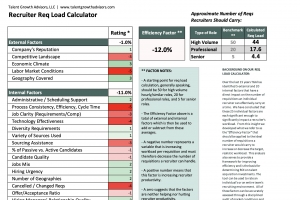RPO Lessons Learned: Spotting RPO Dysfunction

Normally, RPO (Recruitment Process Outsourcing) is thought of as a noun, but more often than you might imagine, it should be considered a verb, conjugated, as ‘ARPOED’. This usage is appropriate when rational guidelines for outsourcing recruitment work are circumvented and a spiral of events take place that inevitably cause the malady to be manifested in one of 3 ways:
- The Money Pit
- The Silent Treatment
- The Bucking Bronco
The good news is the malady of being ARPOED does have a cure (not involving self-inflicted harm of any sort), but first I’ll describe the 3 manifestations in some detail.
Each of these manifestations follows a moment of collective weakness (see part 2 in this series), when an organization decides and an HR function acquiesces, primarily for cost management reasons, to outsource recruitment services for mainstream professional hiring – this can be a stand-alone decision or simply expanding a pre-existing RPO relationship beyond its original scope.
1. The Money Pit
The Money Pit manifestation displays symptoms of skyrocketing, uncontrollable recruiting costs – essentially the opposite financial impact from what was originally expected. Highly disappointed hiring managers demand that HR invests more funds to find the talent they need while the CFO criticizes HR as being fiscally irresponsible.
A common sequence of events that play out in this particular manifestation is as follows:
- Competition in the talent market and dwindling candidate slates expose the RPO partner to hiring manager scrutiny and criticism. The RPO struggles to upgrade resources to compete more effectively and digs into profit margins. Still unable to show well in competitive markets and feeling the financial crunch, the RPO partner extracts meager concessions from the client (e.g. separate screening fees, bonus to avoid search firm fees, upcharge for diversity hires, etc.) and continues to slug it out. Great mutual hand wringing continues as the RPO simply is not able to attract and close the talent that business plans are dependent on.
- Business leaders are pressed to deliver business results but are short on talent to get the work done. Their request to bypass the RPO system and use expensive search firms is approved by the CEO. The RPO is actually relieved with this development and although reduced to collecting only a fraction of its full fee for each search firm hire, is able to compensate by reducing the cost of its own staff.
- A few years down the road and the finance department runs the cost per hire analysis. Cost per hire has skyrocketed to 250% of what was used to justify the original RPO decision, due to fee-on-fee hiring economics and higher cost of in-house supervision – a veritable money pit!
2. The Silent Treatment
Symptoms of The Silent Treatment are, well, silent. On the surface, it seems like recruiting results and satisfaction are OK, despite a sense that something is not quite right. Below the surface, frustrated and desperate hiring managers and business leaders have resorted to skunk-works recruiting efforts, taking their own initiative to build shadow recruiting organizations and engage under cover with outside search agencies.
Here is the typical sequence of events that lead to the Silent Treatment:
- Despite early feedback from hiring managers, the ability of the RPO to deliver the level of talent that business units are looking for does not materialize. Leaders and hiring managers with the most competitive talent needs take action first – and silently.
- An existing position in the hiring organization is designated to focus on department hiring needs. With this dedicated resource, recruiting procedures begin to be redefined for the department. RPO recruiters, who no longer are seen as credible or dependable, are instructed to deliver all resumes directly to the department without screening. Interview protocols and tools are customized by hiring managers, and the RPO recruiters are ultimately relegated to purely administrative work on both ends of the hiring process. With perceived improvement at the department level, additional resources are slowly but surely added to the shadow recruiting efforts.
- Over time, the Silent Treatment solution to RPO underperformance catches on and is widely imitated across the organization. The RPO itself is lying low, earning its fees and off the hook – for the moment. While providing some measure of relief for hiring managers, the organization is still not able to compete effectively in the marketplace for the talent it desires, and this eventually boils up. Finally, the curtain is pulled back, and an audit of recruiting practices reveals a myriad of home-grown approaches across the company’s business units and departments. While visible recruiting costs (through the RPO) appear to be low, when the dust clears and an accurate accounting of resources deployed against recruiting efforts is compiled, the true cost of recruiting far exceeds what was envisioned in the original RPO decision. To top it off, due to completely disjointed recruiting practices, hiring speed and quality are far below expectations. The silence is broken at last.
3. The Bucking Bronco
This manifestation of being ARPOED is characterized by stakeholders being constantly thrown for a loop amid rapid, frantic, and seemingly endless adjustments to recruiting personnel, processes, and technologies – meanwhile, hiring manager disappointment swells as recruiting results continue to stagnate and decline.
The following sequence of events often precedes the Bucking Bronco:
- An existing and chronic backlog of hard-to-fill roles exists across the organization as an RPO is expeditiously put into action as the solution. With near zero time to ramp up and expectations set exceedingly high, the RPO is under-resourced and overburdened from day one – the RPO management team almost immediately senses an endless cycle of red ink.
- HR and RPO frantically review other options for organizing and aligning recruiters, process enhancements, and adding technologies – grasping for any straw to create results, or at a minimum, hope. Revised SLA goals are negotiated that will inevitably be missed. As the new SLAs are missed, more positions are given to outside search firms and costs escalate. Further adjustments are proposed to people, process and technology and the chaos that results amid changes and pressure to find talent escalates all the way to the CEO’s office.
- Costs have escalated beyond budget, business results are suffering due to unfilled critical positions, the CEO wants weekly updates, and both HR and RPO leaders climb into the saddle for a ride on the Bucking Bronco – hold on tight!
----
You may also want to read: Recruiting Process Outsourcing (RPO) Can Improve Hiring Results: Four Ways to Do It. And check out how our Talent Acquisition Consulting Services can help. We've helped many onboard - and offboard - their RPO partners according to their business objectives - Contact us if you'd like to learn more!
Share this Article
Learn more about our unique approach to Talent Strategy Formulation.



